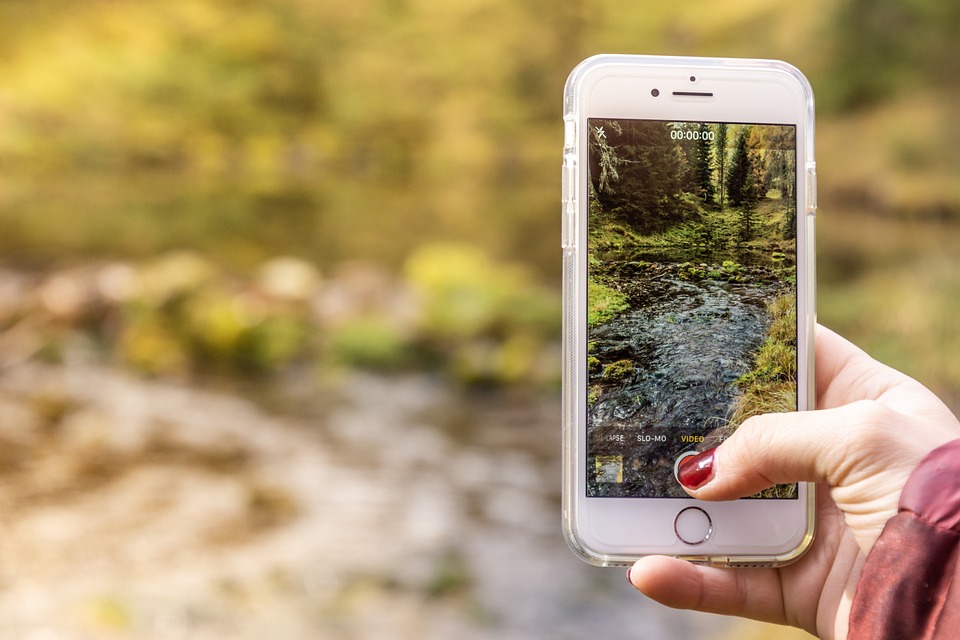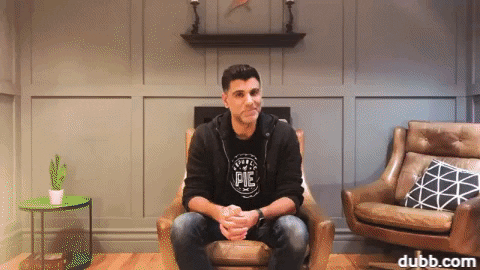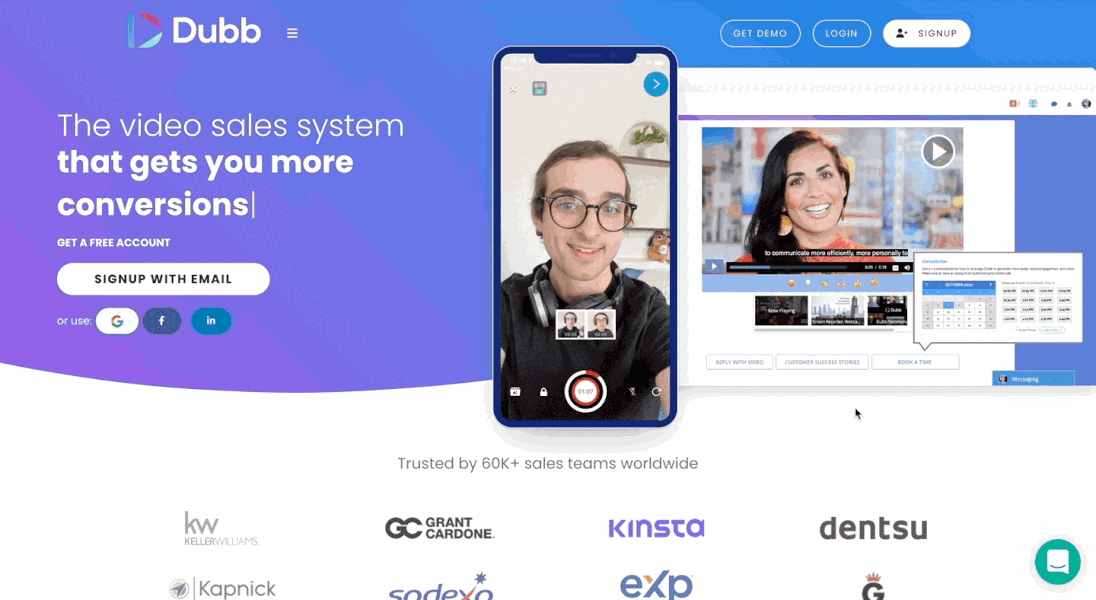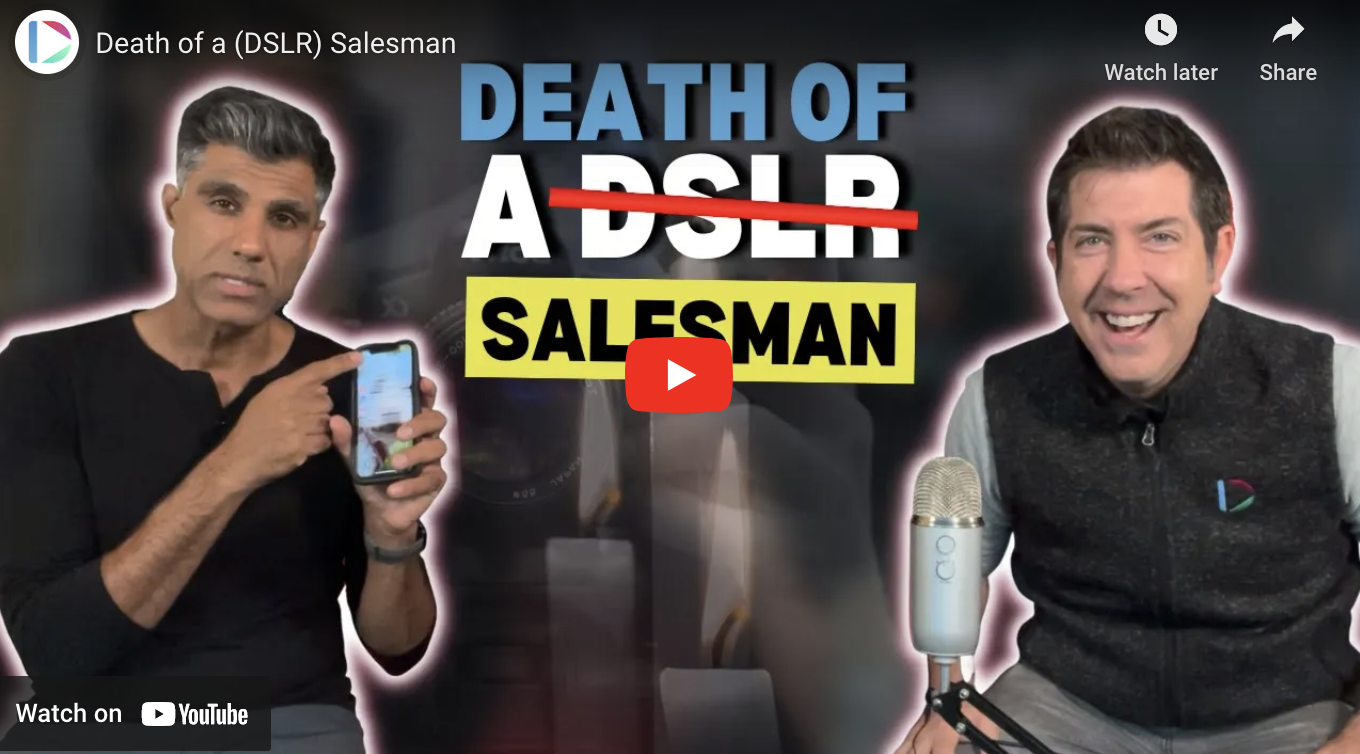In this recap of a recent RevShow episode, you are going to learn about the death of a DSLR salesman and why your production studio is in your pocket. This blog post and video are for salespeople and marketers (not videographers), so keep this in mind as you are reading. If you are interested in getting more content like this, I encourage you to subscribe to future episodes of RevShow. Enjoy!
Do you want to simplify your sales videos and get more time? Do you also want to build a closer connection with your clients and your prospects?
I’m sure the answer is yes. We all want to hit our sales goals and do it as effectively and efficiently as possible. While life isn’t perfect, most of us are searching for a better way to build real, long-term relationships with prospects and generate more sales.
The great news is that there is a way that you can do this. It is by using video. However, we won’t be talking about creating video content through expensive equipment and DSLR cameras. Instead, in this post, I want to take a deep dive into why you can rely on your phone to create professional and engaging sales videos. It may not seem obvious, but your smartphone is a game-changing tool that can help you accomplish your sales and marketing goals. It’s important to dig deep and explore why that is so that you can get the most out of this technology.
And just to be clear: DSLR photographers and videographers are immensely valuable. This video and blog post isn’t meant to disparage their work or say that DSLR photographers have become irrelevant. Rather, I am arguing that sales professionals and marketers can move beyond DSLRs and rely on their phones to create awesome content for their audiences. The death of the DSLR salesman is actually a promising thing, as every salesperson and marketer can use their phones to build closer relationships with their prospects and generate more sales.
Embracing Our Advanced Tools
I don’t like to be the bearer of bad news about anything. It is difficult to share bad news in any type of situation. The great news here, however, is that I am sharing rad news, not bad news. Even though it may seem like you are giving something up in the beginning, what you are gaining is monumentally more powerful.
Here’s the deal: anyone in video marketing or in video production has invested in technology. We all do this and it is extremely easy to go crazy with this. In our minds, we have an image or video that we want to create, so we are willing to invest in whatever we need to bring our vision to reality. For instance, at Dubb, we bought DSLR cameras, microphones, and more. In fact, we set up an entire production studio, which we use to record content for YouTube, for our prospects, and for our customers.
I’m not saying that this type of expensive equipment is useless or irrelevant. We have gotten value from these tools. Rather, what I’m arguing is that sales professionals and marketers don’t need these tools.
The fact of the matter is that the iPhones and Android phones that we have now are extremely advanced. The technology has progressed so much that most of our other technology has become outdated.
Ask yourself: when was the last time you took your DSLR camera and your high-end microphone and then compared the raw video and audio to video and audio taken from your Android or iPhone? If you haven’t done it, I encourage you to do so. It is a quick experiment that will reveal something important.
Chances are that your smartphone is going to look better and sound better. As a viewer, you’re going to find that it is a better experience than watching that video shot with a DSLR camera. Even if that same DSLR camera offers some bells and whistles that you can’t find on your Android or iPhone, you’ll find that your smartphone actually leads to a better finished product. Not only that, as we’ll discuss below, it is easier to create high-quality video content with your smartphone.
As you can guess, your smartphone offers you the best of both worlds. It makes your job easier and you can deliver awesome content that engages your audience. Pretty great, right?

Simplicity and the Pareto Principle
The biggest key we recognized when setting up our production studio was that simplicity rules the day.
Simply put, the technology on smartphones has become so good today. This is true whether we are talking about video quality, sound quality, or even the process of creating the actual piece of video content. With the smartphone in your pocket, you have a substantial ability to create amazing content. It’s like walking around your town or city with a production studio on your device. You don’t need to lug around a heavy camera, record your content, go back to an advanced production studio, and make your edits there. Instead, you can pull out your smartphone, make any edits that you need after recording, and immediately distribute that well-produced video to your audience and fans.
Even better, it is really easy to take advantage of the many different features, including zooming, rack focusing, and more. Apple and Android devices prioritize simplicity and make it seamless to leverage all of these features. In effect, what these devices are doing is releasing the stress of complexity. The opposite of complexity is simplicity and prioritizing simplicity can help you get the job done.
If you really think about it, some of the most successful people on the planet are obsessed with simplicity. They speak about removing all of the unnecessary things from any given situation. Instead, they only want to focus on the things that work. The quintessential example of this is Steve Jobs. Jobs was known for many things, but one of the most significant things he was known for was demanding simplicity in Apple products. Everything from the first Macintosh to the first iPhone prioritized simplicity and convenience. Jobs was obsessed with this fact and his obsession led to the creation of products that customers absolutely loved.
Essentially, Jobs and Apple bought into the Pareto Principle. If you haven’t yet heard of the Pareto Principle, it basically means that 80 percent of our success comes from 20 percent of our efforts. The same idea applies to technology. 80 percent of the production quality, effectiveness, and conversions come from 20 percent of our technology. The Pareto Principle inherently embraces simplicity and recognizes that you can get a lot done with not as much as you may think.
This is quite liberating. Simply put, it means that you can simply get rid of the things that you don’t need. As a sales professional, you can stop using that DSLR camera that you purchased several years ago. You don’t need to use unnecessary lights and that super bulky microphone that has been in your closet. While it may feel like we need to use these tools (after all, we paid for them with our hard-earned cash), those sunk costs are holding us back. They are preventing us from using the “simpler” tools that we have to create our sales and marketing content. But by embracing those simpler tools, you’ll find that your video content is better and more engaging.
Now, there is something critical to note here. I’m specifically referring to nano technology. If this is the first time you have heard the term, you can think of nano technology as technology that occurs at the smallest level. Further, if you think about the camera inside of your iPhone or Android, you probably think of it as a very small camera. By contrast, if you look at your standard DSLR camera (especially if it is a full-frame camera), chances are that the sensor is going to be significantly larger. As you can guess, larger does not mean better. Today’s technology is getting so advanced that our smaller devices are some of the fastest and most powerful on the market today. So if you are looking for sheer power, speed, or the most technologically advanced devices out there, I encourage you to embrace nano technology.
Ultimately, when you simplify things and are smart with your technology, you unlock something important. You make your videos all about building a true visual connection, which lets you connect on another level when you are pitching your customers. It even helps you as you are trying to connect with your script and as you are articulating your message to the coldest of prospects. It is actually the perfect vehicle for not only visual connection (because you have simplified everything by using only the most relevant technology), but for human-to-human connection.
So what does this all mean? Your smartphone can help you embrace simplicity and the Pareto Principle. It can help you create high-quality videos whenever you’d like. The DSLR salesman can easily transition from shooting grainy footage on heavy equipment to shooting crisp footage from their smartphone.
A Case Study in Moving Beyond the DSLR Salesman
To illustrate the power of moving beyond the DSLR salesman and embracing content creation from our smartphones, I want to share our experience of how we moved beyond a tech-heavy setup to using smartphones in our sales and marketing content.
Our evolution on RevShow has been interesting. We started with a DSLR camera. From there, we moved on to a live streaming environment, where we decided to use several webcams. We also had a console, which helped us easily select the different webcams that we wanted to use. The reality in doing this, however, was that the quality of our videos was all based on webcam resolution (which wasn’t very good). If our editor Sebastian wanted to zoom in on a particular part of the video, the overall video would look extremely blurry and pixelated. The same thing happened if Sebastian wanted to do punch-ins on our faces. It wasn’t Sebastian’s fault; rather, the problem was the equipment that we were using.
Consequently, we decided to do exactly what I am telling you here. We now use our smartphones to make video content. We specifically use an iPhone 13 in cinematic mode and we record audio through an external microphone. We include some lighting and that is essentially it. We couldn’t be happier with this simple setup. This basic setup allows us to film zoom-ins, punch-ins, and really anything that we want. We can even take advantage of the Bokeh Effect, where the subject matter is clear and where the background is slightly out of focus.
Think about this for one second. Imagine if you could have the simplest possible production environment. You can record at an extremely high resolution and rely on a simple, high-quality microphone that is capturing your voice. Along with this, imagine using a simple light setup that lets you be consistent as you are recording different types of video content. With this light setup, create high-value content that you can publish on all of your channels. How much better does that sound than having clunky DSLR cameras on tripods, big studio lighting, and big studio microphones? All of these tools look much larger than the quality that they provide. The DSLR salesman who relies on these tools will have a much harder time than relying on the simple setup that I described above.
The key here for the DSLR salesman? It is about moving away from those clunky tools and embracing simplicity, authenticity, and effectiveness.
When we are talking about simplicity, we are talking about sustainability. The big thing that we have discovered when simplifying is that we create a workable environment. What you don’t want to have happen is to be backed up into a corner with all of your trinkets and technology. You don’t want to be in a position where you need to manage all of these tools as you are recording your sales and marketing videos. Instead, what you want to do is simplify all of it. Doing this absolutely pays off. For instance, if you were to place the simplified and non-simplified videos side by side, it’s likely that the simplified video is going to look fantastic. Ultimately, don’t let the chase of perfection, education, and trinkets be the enemy of simplification and sustainability.
Along with this, recording video content with a simplified setup lets you be more authentic. It also helps you communicate in a more effective way. This happens, once again, because of the simplicity that comes with recording with your smartphone. Instead of needing to make decisions about backgrounds, sets, and even costumes, you can simply pull out your phone and start recording. This forces you to truly be yourself and to honestly speak to the camera. While this may be scary at first, it actually makes your message more effective. Your audience members can see the true you. Even if you have flaws, those flaws make you more relatable and more human. It dramatically increases your chances of building a real connection and converting a prospect into a paying customer.

The Magic of Video for Sales and Marketing
There is something so magical about using video for sales and marketing. That magic comes from the fact that you get to leverage humanity at scale.
But let’s back up for one minute. Typically, there is this inverse relationship when we are discussing humanity and scalability. As humanity increases, there is less scalability. By contrast, as something becomes more scalable, it tends to become less human. This inverse relationship is difficult because we want both things. We want to create content that shows our human side and we want to do it for large audiences.
What is so interesting about this is that video makes us more scalable. This is because video can be watched by countless numbers of people. Through the power of the internet, there is really no limit on the number of people that can watch your videos. You can post your video to YouTube (or some other social network) and go viral overnight. Even if you don’t reach millions of people as the next viral overnight star, you can reach thousands of people on your email list. Whether you have an email list of prospects, customers, or a mix of both, you can easily send a video to thousands by simply clicking on a few buttons.
Even better, you can incorporate the same message (with the humanity and personalization that you apply to one person) at scale. If you are a Dubb user, for instance, you probably already use our personalization text feature. This means that you can add personalization to virtually any video that you have already created. This is just one way that you can personalize your message at scale, and it is something that you will find useful in many (if not all) of your video sales and marketing campaigns.
Ultimately, video is scalable and repeatable, which is one of my favorite phrases at Dubb. It can supercharge your sales and marketing work—especially if you avoid the attitude of the DSLR salesman and embrace the recording studio in your pocket. By doing this, you will be well on your way to hitting your sales goals.
Marrying Technology and Story
Do you know what is so much more important than technology? If you read this blog or regularly watch RevShow, you probably know that it is story.
Video is about telling stories. There is a narrative, a plot, an arc, a beginning, a middle, and an end. The more time we spend creating stories, capturing content, and publishing that content, the higher the chances that we will build connections with our audiences. It is a much better use of time instead of obsessing over technology and going down that rabbit hole.
The important thing is selecting the right technology. While technology makes our lives easier, we need to choose the technology that actually fulfills this goal of telling awesome stories. Once you have chosen the technology that actually simplifies things, you are in business.
This is the great thing about abandoning the DSLR salesman attitude and embracing your smartphone. By using your smartphone to record sales and marketing content, you essentially have no limits. You don’t need to record all of your videos in your office or studio. Instead of that, what you can do is record wherever you are. If you are walking or driving to work, you can record a quick sales video. If you are in the middle of a walking brainstorming session with your team, nothing is stopping you from recording another brief video. You can even host an FAQ or Q&A session on your product or service when you are at a trade convention or an expo. Whatever the case may be, smartphones make it much easier to tell compelling stories. Even if it is just you speaking to the camera, you are in a much better position to tell an awesome story to your audience.
Now, there’s an important aside here. When you are recording a video, make sure that you are being intentional with your shots. For instance, if you are making a video about a particular subject matter, that subject matter should be the focus. Be intentional about what your subject and shot are—even if you are recording video content with your smartphone.
With that understanding in mind, the best thing to do is to get into the habit of recording with your smartphone. So go ahead and pull out your phone when it is convenient. Practice pitching a prospect or customer. Even if you don’t end up sending that video to the prospect or customer, you are gaining valuable experience that you can then use in future videos.
When you are creating, however, make sure that you keep story at the top of your mind. If you are able to do this, you are putting yourself in a fantastic position to create high-quality, compelling video content. The payoff? You will likely see more conversions and sales.
Avoiding the Paradox of Technology and the DSLR Salesman
To wrap up this discussion, I want to offer a warning. Throughout this entire conversation, we are trying to avoid a specific scenario. As someone who has worked with a team that has built a software platform and spent part of my life focusing on building innovative technology, I have realized that there is a paradox in technology.
The paradox is this. For example, let’s assume that we purchase an electric bicycle. We’re all excited to use our electric bicycle in our towns and cities. Now, however, we come across a problem. We need to figure out how to charge that electric bicycle. We then need to determine how to replace the battery. If the wiring gets burnt, we then need to figure out how to repair that wiring. And if we run out of electricity on a ride? We need to determine how we can transport the bicycle back home.
All of these issues show us that technology can help us. The electric bicycle itself can provide immense value to our lives, whether we are using it on our commutes or want to use it for fun on the weekends. That being said, the same technology can present new problems to us. As we solve those problems, we come across even newer problems. We find new technology to solve those problems, and then the cycle continues.
When this happens, we find ourselves in a cyclical loop of consumerism. We are spending money on technology, implementing that technology, finding problems, getting more technology, and then finding even more problems. It never stops and it can be pretty draining.
To be clear, this is the opposite of what you want to do in your video marketing. Get yourself in a situation where you can take your smartphone, record a video, do some minimal editing, publish that video (whether it is in the form of a post on a social channel, video message, or email campaign), and make a connection. Do not spend your time in the rabbit hole of technology because it is endless. While it may seem benign as it is happening, this cycle wastes time and gets you further away from your sales and marketing goals. It is the attitude of the DSLR salesman and something that you absolutely want to avoid.
Moving Beyond the DSLR Salesman
The death of the DSLR salesman doesn’t need to be a sad affair. In fact, it can be an extremely liberating thing. By embracing the smartphone that you likely have in your pocket, you can quickly create stunning videos that engage and convert. In other words, using the tools that you likely already have, you can build stronger relationships with your prospects and generate more sales.
Whether you are a brand new sales professional or a sales leader at an extremely large organization, I encourage you to keep these tips in mind. The easiest thing you can do is start small, whether that means recording a smartphone video for your eyes only or a quick smartphone video for one of your favorite customers. These little steps may not seem like much in the moment, but they will help you get beyond the DSLR salesman attitude and more toward becoming a content machine. I wish you the best of luck!

If you would like to learn more about how Dubb can help you reach your sales and marketing goals, click here. We also invite you to click here if you have any questions or comments about this blog post. And if you would like to give Dubb a try? Click here for a free 14-day trial of our premium plans.


